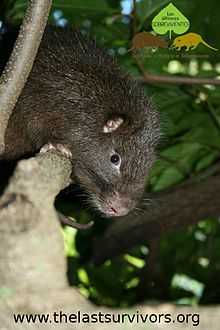Hispaniolan hutia
| Hispaniolan hutia | |
|---|---|
 | |
| Conservation status | |
| Scientific classification | |
| Kingdom: | Animalia |
| Phylum: | Chordata |
| Class: | Mammalia |
| Order: | Rodentia |
| Family: | Capromyidae |
| Genus: | Plagiodontia |
| Species: | P. aedium |
| Binomial name | |
| Plagiodontia aedium (F. Cuvier, 1836) | |
The Hispaniolan hutia (Plagiodontia aedium) is one of several hutia (also called zagouti, and jutía in Spanish) species to have inhabited at some time the island of Hispaniola (island shared by Haiti and the Dominican Republic). The P. aedium is the only scientifically confirmed extant species of the genus Plagiodontia; other species are either extinct or being debatedly catalogued as P. aedium subspecies. The name Plagiodontia means "oblique tooth" in Greek.
Description and behaviour
Head and body length is about 312 millimetres (12.3 in) and tail length is about 153 millimetres (6.0 in). The listed adult weight as 1.267 grams (0.0447 oz). In the species P. hylaeum, head and body length is 348–405 millimetres (13.7–15.9 in) and tail length is 125–45 mm. Judging from the skeletal remains, the largest species in the genus is P. ipnaeum (or Samaná hutia) and the smallest is P. spelaeum. In the living species, the short, dense pelage is brownish or grayish on the upper parts and buffy on the underparts. The tail is scaly and practically naked. Both the forefoot and the hind foot have five digits, all armed with claws except the thumb, which has a short, blunt nail. Females have three pairs of lateral thoracic mammae.
Captive hutias have been observed to be nocturnal and arboreal and to use nest boxes placed high off the ground. Wild P. aedium are reported to be active only at night, to hide during the day, to feed mainly on roots and fruits, and to live in male-female pairs. Reports also stated that three or four individuals commonly occupy the same burrow system. Specimens of P. hylaeum were caught in December in hollow trees near a lagoon; four pregnant females each contained a single embryo. Purportedly, captive female P. aedium have an estrous cycle of 10 days, a gestation period of 119 days, and apparently a single offspring. Recorded gestation has been 123–150 days and litter sizes of one to two young in this species, which are highly precocial, much unlike most rodents, which are totally helpless when born. A captive P. aedium was still alive after 9 years and 11 months. Individuals communicate through soft, almost bird-like chirps.
Ecology
Hispaniolan hutias inhabit forests. It is reported that they occupy rough hillsides and ravines from sea level to 2,000 meters in elevation, that some populations use burrows and feed near the ground, and that other populations may den in tree cavities and move through the trees, rather than descend to ground level.
Five of the seven species in this genus are known only by skeletal remains, often found in association with human kitchen middens. These five species probably disappeared by the seventeenth century because of excessive hunting by people. P. aedium and P. hylaeum have been greatly reduced in range and numbers and are threatened by deforestation, hunting, and predation by the introduced mongoose (Herpestes auropunctatus). The human population of Hispaniola is increasing, most of the island's forest cover is being cleared for agriculture, and hutias are killed whenever encountered.
The IUCN regards P. hylaeum as a subspecies of P. aedium. P. a. hylaeum is called the Dominican hutia, while the nominate race, P. a. aedium is referred to as Cuvier's hutia. Recent surveys in Haiti have found P. aedium to be somewhat more common than once estimated, though still in jeopardy, and also have received unconfirmed reports of the possible survival of P. velozi. The IUCN Red List classifies the P. aedium as "vulnerable". Recent genetic research has identified three distinct populations of P. aedium
Its presence in several protected areas has recently been confirmed by a Darwin Initiative funded project known as The last survivors - these include: Jaragua, Del Este, Los Haitises National Park and Sierra de Bahoruco National Park. Hutia population have also been discovered in privately protected areas such as Punta Cana Ecological Reserve. There were sightings in 2005 which were confirmed photographically (E.M. Fernández, et al. - see external links) in the Bahoruco region and evidence suggest that this area may have a substantial hutia population in and around the protected area.
See also
- Hutia
- Hispaniolan Solenodon
References
- ↑ Turvey, S. & Incháustegui, S. (2008). Plagiodontia aedium. In: IUCN 2008. IUCN Red List of Threatened Species. Retrieved 6 January 2009.
External Links/Sources
- The last survivors conservation project
- Hispaniolan Hutias
- Parque Nacional Armando Bermúdez
- Parque Nacional Jaragua Grupo Jaragua
- Plagiodontia aedium The Animal Diversity Web
- West Indian Mammals Includes the best photos of P. aedium available on the web.
| ||||||||||||||||||||||||||||||
